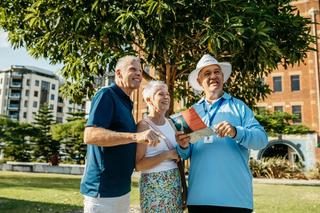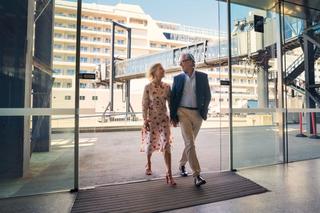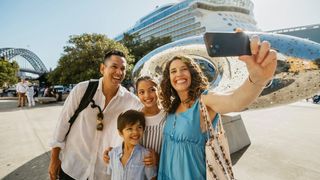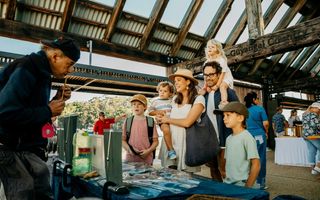There are plenty of opportunities to make the most out of cruise visitation. Visitor economy businesses in NSW can offer their products as part of a cruise line’s official shore excursion program; which are organised and booked by a ground handler. Alternatively, passengers can book independent tours directly with an operator – online or through a visitor centre. Retail outlets also benefit from cruise passengers and crew.
How to work with the cruise industry
Cruise tourism presents a wealth of opportunities for businesses and individuals. Understanding how cruise passengers find, book and explore a destination can help you tailor your offerings and maximise the benefits of cruise tourism.
Cruise shore excursion programs

Shore excursions (“shore-ex”) are the official tours and experiences offered by cruise lines. Each cruise typically features a variety of excursions, which are often pre-booked by passengers when they reserve their cruise or when on board, with some cruise lines offering select tours as part of the fare. Shore excursions are a key revenue source for cruise lines.
Cruise distribution roles:
- Cruise lines maintain direct relationships with their customers (the cruise passengers) and have full control over the shore excursion program. Cruise lines curate, promote and sell tours to their guests, ensuring alignment with their brand. Additionally, cruise lines handle customer feedback, including satisfaction surveys and complaint resolution.
- Ground handlers, also known as shore operators, destination management companies (DMCs) or cruise inbound tour operators (ITOs), are contracted by cruise lines to manage and deliver their shore excursion programs. They design itineraries, arrange transportation and guides, and coordinate all operational aspects of an excursion to create a seamless experience for passengers. Ground handlers also oversee logistics on the day, working closely with the onboard teams to direct passengers and ensure timely returns to the ship.
In addition to shore excursions, ground handlers also provide hotel services and pre- or post-cruise holiday packages for passengers extending their travels. This may also include overland touring – a growing segment of well-planned end-to-end itineraries, where passengers disembark at one port for a few days to explore a destination before they rejoin the ship at the next port of call, remaining on land for a few nights. Overland experiences will typically offer high-quality, money-can't-buy experiences. - Visitor economy businesses are the tourism businesses offering a tailored experience, whether it is a tour, an attraction, a restaurant or accommodation. Through the official cruise shore excursion programs, the visitor economy business deals with the ground handler for quotations, bookings, final numbers and invoicing.
Independent tours
Independent tours are experiences or tours that cruise passengers book outside of the cruise line’s official program. Bookings can be made at various stages – before departure, during the cruise or even last-minute on the day of arrival. Industry studies indicate that 40-50% of cruise passengers visit a port without a pre-booked shore excursion. Independent tours are especially popular among Australian passengers.
Tips to attract direct bookings:
- Ensure your tour or experience is easily discoverable online and bookable for days when cruise ships are scheduled to be in port.
- Optimise your website with cruise-specific content and SEO keywords.
- Leverage social media and encourage guest reviews.
- Adjust your tour or experience departure times to the cruise schedule if necessary, to capture cruise passengers arriving in port.
- When offering an independent tour, it is essential to have passengers back on the ship well in time before departure, as the ship will not wait for them.
- Cruise passengers seeking an independent tour often make their way to visitor information centres upon arrival at the port, so ensure you contact these centres to inquire about having your product available.
Crew opportunity
Cruise ship crew – waiters, bartenders, engineers, medical teams, retail staff and entertainers –play a key role in shaping passenger experiences. Like a concierge, they often guide passengers on where to go and what to do on shore. Engaging with crew can help build long-term advocacy for your business and experiences. Consider offering discounts for crew members or create a tour tailored to crew, as crew frequently return to the same ports. Crew also rate ports for ease and satisfaction, influencing future cruise itineraries.
Retail engagement
Retailers can benefit from cruise visitors and crew by ensuring they are open and operating on cruise days and offering special deals to appeal to cruise passengers. Simple gestures – such as a 10% discount on coffee, free wi-fi or a friendly welcome sign – can encourage foot traffic and boost sales.
Cruise line alcohol policies
Each cruise line has specific rules regarding food and beverage products, particularly alcohol. While most ships allow passengers to bring beer, wine, and spirits onboard, many restrict onboard consumption, storing purchases until the final port of debarkation.
- Review Australian Cruise Association (ACA)’s Alcohol Guide for Australian Ports.
- Offer a freight home option for large or high-value alcohol purchases.
- Provide interpretive signage to assist international and non-English-speaking passengers.
Other ways businesses can engage with cruise
Adjust opening hours and staffing
- Check the cruise ship schedule and adjust your business hours to accommodate cruise visitors. If a ship arrives on a day you're usually closed, consider opening to take advantage of the influx of potential customers.
- Ensure adequate numbers of trained staff to manage high numbers of cruise passengers over a short time period.
Engage locally
- Participate in local markets or events that align with cruise ship visits.
- Promote special offers for cruise visitors with signage outside your venue.
- Highlight local products and menus to attract cruise passengers looking for souvenirs or unique dining experiences that represent the location.
For individuals
If you are an individual and want to get involved, consider:
- Volunteering at the port to welcome ships (especially in regional areas).
- Becoming a tour guide to showcase your destination.
- Working as a translator if you speak languages other than English.
Tailoring your experiences to the cruise market
Accommodate diverse group sizes
- Tailor your product to handle a wide range of group sizes, from couples to groups of 200 or more. Consider how your experience may vary depending on group size and ensure your offering can scale accordingly.
Identify market restrictions
- Family-friendly: many families see cruising as an affordable travel option. How can you adapt your product to meet their needs?
- Accessibility: ensure your experience caters to those with limited mobility or disabilities.
- Time constraints: take into account any time limits imposed by the cruise schedule.
Efficient group management
- When catering to large groups, manage scheduling efficiently by offering multiple smaller group options throughout the day. Consider partnering with other operators to create flexible itineraries that accommodate different group sizes or provide back-to-back visits.

What are cruise passengers looking for?
Cruise passengers want to meet, connect and be immersed when they travel. They are also looking for local flavour. Look at ways to include local landscapes, people or produce, aim to weave in an educational component and include immersive experiences that reflect the character of the destination.
Current trends
Nature-based experiences and outdoors experiences
Cruise passengers tend to appreciate the local environment. Activities such as nature tours, bike riding or guided walks through national parks and nature reserves are popular.
Culinary experiences
Authentic food and wine experiences are in high demand, so consider offering bespoke experiences such as:
- Meet the maker or behind the scenes tours.
- Hands-on cooking classes, oyster shucking or chocolate tastings.
- Wine or food tastings at local cellar doors, distilleries or breweries.
Showcase seasonal produce and emphasise what’s fresh and available now. Keep in mind that passengers tend to eat heavily on the ship, so lighter meals or unique food experiences often appeal more than large meals.
Aboriginal-owned and led experiences
- Aboriginal cultural experiences are of particular interest to the international cruise market.
- If you are an Aboriginal-owned operator or have an opportunity to collaborate with an Aboriginal operator or Aboriginal guide; it’s important that the content is delivered in a way that is culturally appropriate and aligns with the aspirations of local Aboriginal communities.
- It’s also important to ensure that whenever interpretation of Aboriginal sites and stories are done, it’s done by an Aboriginal person or with permission from the local community.
Be accessible and inclusive
- The increasing number of accessible cabins across cruise fleets highlights the growing importance of catering to passengers with diverse needs. Ensure your experience is welcoming for people of all ages and abilities.
- Consider accessibility for parents with prams, seniors with mobility needs and individuals with permanent or temporary disabilities.
- By creating inclusive experiences, you make your destination more accessible to a broader range of cruise passengers.
- For more insights, look at our Quick tips for creating accessible and inclusive experiences.
Sustainability
Sustainability is a vital part of a visitor's experience. Not only does it benefit your business but it also helps preserve the environment for future generations.
Some practical tips for sustainable cruise experiences include:
- Encourage visitors to be mindful of waste and provide easy-to-use recycling bins or reusable water bottles as souvenirs.
- If operating in nature, protect wildlife, reduce carbon emissions, and use resources responsibly.
- Showcase sustainable and socially responsible elements of your experience by offering vegan menu options, ocean-friendly sunscreen and fair-trade coffee.
For more information on being sustainable see Quick tips for creating sustainable experiences.

How to become part of cruise shore excursion program
To be included in a cruise line's official shore excursion program and offer your experience to passengers, you’ll need to partner with a ground handler.
Key steps
Develop a unique cruise experience
- Customise your offering to stand out, as cruise lines typically avoid competing products. They usually won’t feature your public offerings but are open to unique experiences that cater specifically to their passengers.
- Be creative and craft exclusive experiences that can’t be easily found through a simple online search.
- By avoiding direct competition with public offerings, you'll create value that cruise lines will appreciate – offering something unique outside of their standard tour options.
- Enhance the experience with special touches and inclusions that provide extra value and make it memorable for guests.
- Create moments that are visually captivating and encourage passengers to share their experiences on social media. Think of photo-worthy spots or activities that guests will want to capture and post. Don’t forget to share your own branded hashtags, making it easy for guests to tag and promote your product.
Work with a ground handler
Cruise passengers can book a shore excursion in advance or while on board their ship. On smaller expedition ships, shore experiences are often part of a prepaid package. In both cases, the shore excursions are coordinated by a ground handler and typically include experiences tailored specifically to cruise passengers.
- Sales kit and fact sheet
While a formal sales kit (or trade kit) isn’t strictly necessary for cruise tours, it can help clarify the experience and its inclusions. Many ground handlers provide their own templates, so you may be asked to complete a document that outlines all the details needed for cruise line proposals.
Destination NSW offers information on creating a sales kit and provides templates that you can use – available here. - Pricing
Ground handlers typically work with net rates for bespoke and unique products that differ from your standard/published offerings. If you’re providing a package available on your website, you may be asked to offer a 30% commission, similar to what an inbound tour operator (ITO) would expect. - Catering for cruise ship guests
Most shore experiences are within a 30-60 minute transfer from the port. If you have your own transport, including a transfer to your experience can be an added benefit. Be sure to have a host on board to offer commentary and enrich the guest experience. If you don’t provide transport, the ground handler will arrange transportation to support your experience. - Flexibility
Aim to remain as flexible as possible with your trading terms, as factors beyond the cruise lines' control – such as weather conditions, late passenger bookings and cancellations – can lead to changes in numbers. Ensure your terms and conditions account for these uncertainties.
While bookings are often made well in advance, passenger numbers and final details can frequently change, with adjustments sometimes occurring right before departure.

Tips to prepare for cruise season
- Know the cruise season
Cruise season in Australia runs from October to April, with the peak period being December to March. Some domestic and around-the-world ships operate year-round in Australian waters. Ensure your cruise product is available during the cruise season and offers exclusive experiences for passengers. - Plan ahead
Cruise itineraries are typically planned 18 months to three years in advance. Commit to having your tours, attractions and activities available well ahead of time, including agreeing on rates. - Cruise is a complement to your year-round business
In some regional ports, cruise ships may visit only a few days per year. Ensure any cruise-specific experiences complement your year-round offerings. - Time management
When cruise ships visit a port, passengers typically book shore excursions lasting two to six hours, including transfers within 30-60 minutes from the port. Allow free time for passengers to explore the port independently but be sure your experience fits within this timeframe and ensures timely return to the ship.
Key things to remember
- Seasonality: cruise business is seasonal, so treat it as an add-on to your existing business mix.
- Port limitations: not all ships can dock at every port due to size and facility constraints.
- Audience diversity: different ships attract different passenger profiles, so tailor your experiences to suit specific cruise lines.
- Offer unique experiences: cruise passengers seek to experience local places, people, and produce, so offer experiences that stand out from your standard offerings and provide an immersive connection to the destination.

.jpg?rect=406,0,3189,1993&w=320&h=200&fit=min&auto=format)

